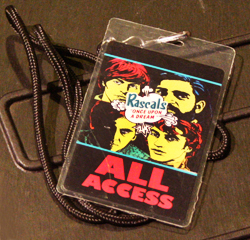
Adapting Realities
Chris Edwards mixes front of house for “Once Upon A Dream.” Originally the engineer at the Capitol Theater in Port Chester, NY, he joined the tour after working the initial out-of-town tryout at the Capitol to the satisfaction of director Van Zandt.
“I walked in and the theatre’s production manager said, ‘it looks like you’re going to be mixing the Rascals’,” Edwards recounts. “Steven sat with me every single night. He knows every note of every one of their records. He understood that I was a musical mixer and not just another dude in a bad Hawaiian shirt. Steven definitely had input. Trying to grasp 30 songs of new material, I didn’t hit it on the head every time, but as soon as we were cool, we were cool.”
As noted, Edwards is a music mixer by training, and has had to adapt to the realities of managing a highly-cued, theatrical type show. “The show has extensive narration that accompanies the video portions between songs,” he explains. “Many of the initial narration came from different sources with inconsistent levels and EQs, adding that getting various pieces of narration to sound right through the system was challenging: “I had never used any kind of snapshots, but (initially) I just dove right in using them to manage dialog levels and EQ.”
Later, Geoff Sanoff from Van Zandt’s Renegade Studios re-worked the narrative post-production audio to make it more consistent. Edwards: “The first time I heard the remixed dialog I hugged him. I later chose to abandon using snapshots altogether. I have a lot of experience working in old analog studios with no automation or Pro Tools, and these skills have been very useful to me in this production.
“I always approach the mix to honor the music,” he adds. “I’m a musician and deeply rooted in music, and have a great respect for these artists. I spent eight years as a stage tech with Levon Helm and recorded the Rambles at his barn. For me, it’s an honor to mix this show; I’m just trying to place all the parts where they should be dynamically, and pay homage to all the nuances.”
Edwards mixes on a Midas PRO6 digital desk supplied by Firehouse Productions, using loudspeaker systems provided locally by the venue in order to manage production costs. I had the pleasure of hearing two performances at Royal Alexandra Theatre during my visit to Toronto, and can testify first-hand that Edwards provides mixes with great vocal and instrumental clarity, while enhancing subtleties in the arrangements resulting in a believable, entertaining presentation.

Very Comfortable
Jeff Child is an independent systems tech provided by Firehouse Productions, managing another pile of gear no one could have imagined 40 years ago. Child usually tours with technology-savvy Ultrasound accounts including Dave Matthews, Further, and Phil Lesh and Friends. He struck me as very comfortable in this setting, managing adjustments for the house-supplied d&b audiotechnik Q Series line arrays with two B2 subs left and right. Q7s handled in fill and front fill duties.
“Stacks and racks are what we usually pick up. The balance is provided by Firehouse or owned by the band. Both Mark and Chris have extensive house engineer, broadcast, and studio backgrounds, so I bring a touring rock sensibility to this,” Child explains.
As noted earlier, Kingman is responsible for RF equipment and frequency coordination, and also handles earpieces and beltpacks for the artists. He uses Intermodulation Analysis Software from Professional Wireless Systems and a WinRadio spectrum analyzer to coordinate frequencies.

“Frequency coordination here in Toronto has been easy,” he tells me. “I was informed that no licenses were required. To date, I’ve only had to change one frequency. The loudest thing onstage is Dino’s drums, and keeping drums, shakers, and tambourines out of vocal mics is the greatest challenge. Being older guys, the in-ear environment is very different. Our main role is to let them know ‘we are here to make you comfortable’.” In-ear electronics are Sennheiser ew300 IEM G3 systems with a Sennheiser combiner and helical antenna. All artists are on Ultimate Ears UE-11 earpieces.
Prentice notes that fortunately, the Rascals have adapted well to the profound changes in performance technology. “They’ve all become really, really comfortable in that environment. Now we just stick these little things in our ears and do a show, and I think you miss all the technological magic that has to exist to make that happen.” Fortunately for the Rascals, that technological magic happens every day because of innovation and a talented crew offering them a supportive musical environment in sharp contrast to when they first began.
“This whole phenomenon that we’re enjoying now, this re-visitation of almost 50 years ago, is about young guys that got together and cooperated and protected each other, and created together, and it was like a chance at peace,” concludes Brigati.
Danny Abelson is a consultant that specializes in the design and construction of technology systems in professional and collegiate sports facilities.

